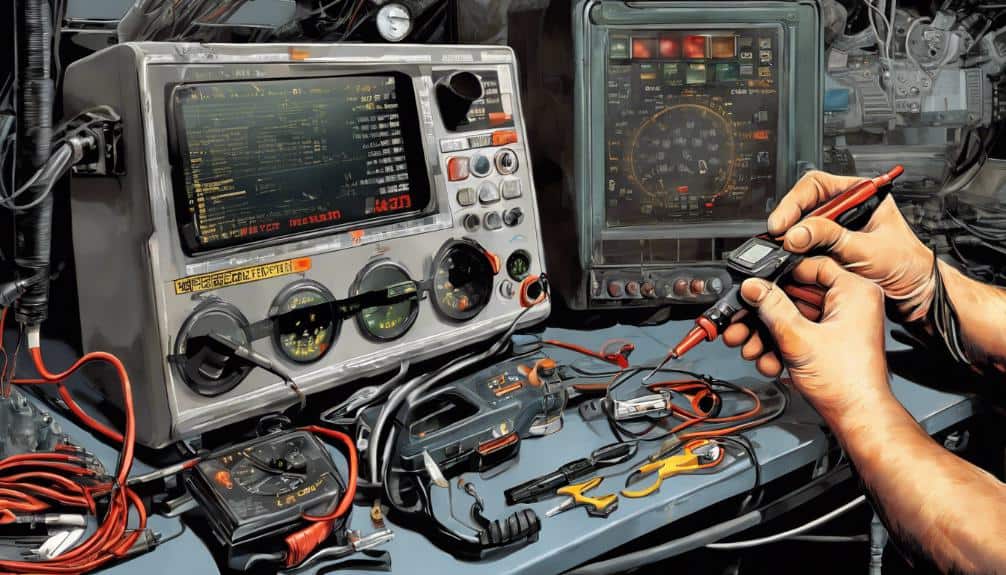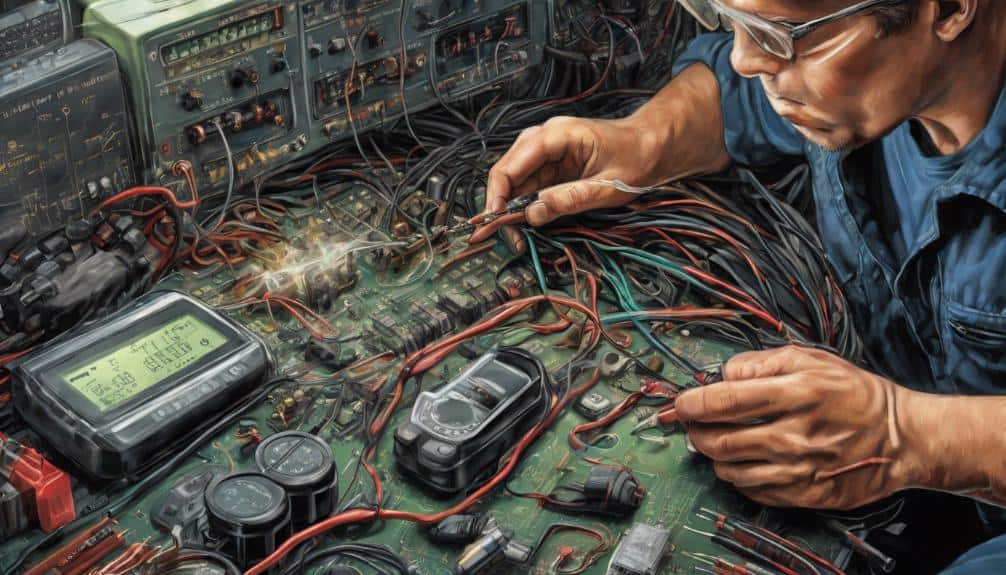When faced with the enigmatic P0202 code indicating an injector circuit malfunction, you find yourself exploring a labyrinth of possible causes and solutions.
As you commence on the journey to solve this intricate puzzle, a methodical approach is key to revealing the underlying issue plaguing Cylinder #2.
Key Points
- Identify root cause of P0202 code through thorough troubleshooting techniques.
- Check for wiring damage, connector issues, and PCM faults as common culprits.
- Utilize diagnostic tools like noid light and spray test for accurate assessment.
- Conduct step-by-step testing to confirm injector functionality and pinpoint malfunctions.
- Address issues promptly with appropriate repair solutions to optimize engine performance.
Understanding P0202 Trouble Code

Understanding the P0202 trouble code is essential for diagnosing and resolving issues within the injector circuit on Cylinder #2.
When faced with this code, it indicates a specific problem with the fuel injector on Cylinder #2. To tackle this issue effectively, you need to employ proper troubleshooting techniques.
By understanding the intricacies of the P0202 trouble code, you can pinpoint the root cause of the problem.
This code typically arises due to a fuel injector malfunction, where the injector fails to deliver the correct amount of fuel to the cylinder, leading to issues in the combustion process.
To address the P0202 trouble code, start by checking the connections to the injector and ensuring there are no loose wires or corrosion present.
Next, inspect the injector itself for any signs of damage or clogging that could impede its functionality.
By systematically troubleshooting these components, you can identify and resolve the underlying issue causing the injector circuit malfunction on Cylinder #2.
Common Causes of Injector Circuit Malfunctions
Common causes of injector circuit malfunctions may stem from issues such as wiring damage, connector problems, or faults in the PCM.
When faced with injector circuit issues, conducting a thorough wiring inspection is vital. Look for signs of chafing or wear on the wiring harness that could lead to shorts or open circuits.
Connector problems are also common culprits; consider replacing any corroded or damaged connectors to guarantee a secure connection. In some cases, faults in the Powertrain Control Module (PCM) may be to blame.
Proper PCM diagnosis and troubleshooting techniques are essential to pinpoint any potential issues accurately.
Diagnostic Tools for Troubleshooting P0202

To effectively diagnose P0202 injector circuit malfunctions, utilize diagnostic tools for accurate troubleshooting.
Start by using a noid light to confirm proper pulsating current to the injector for a functionality test. This tool helps verify that the electrical signal is reaching the injector as it should.
Also, conduct a spray test to observe the injector’s fuel spray pattern, ensuring it’s functioning correctly. This test can help identify issues with fuel delivery.
It’s important to check for potential wiring problems such as chafing, grounding issues, or harness damage.
Inspect the entire wiring loop and harness clip connection to the Powertrain Control Module (PCM) for any visible damage that could be affecting the injector circuit.
How Can Injector Circuit Malfunctions and Exhaust Gas Recirculation Flow Malfunctions Be Resolved?
When facing injector circuit malfunctions and exhaust gas recirculation flow malfunctions, solving EGR P0400 malfunction may require checking the wiring, connectors, and vacuum lines. It is also important to inspect for any clogs or carbon build-up in the EGR system and make necessary replacements or repairs as needed.
Step-by-Step Testing Procedures
For a systematic approach to diagnosing injector circuit malfunctions like P0202, start by confirming the injector’s resistance to guarantee proper functionality.
Utilize testing techniques such as using a noid light to test for injector pulse and make sure proper operation.
Conduct an electrical check by performing a spray test to confirm fuel spray and injector performance.
Troubleshooting tips include inspecting the wiring harness for potential damage or issues that may be causing the malfunction.
Then, consider conducting diagnostic methods on the PCM and other related components to check for faults or failures.
By following these step-by-step testing procedures, you can efficiently identify the root cause of the injector circuit malfunction and work to rectify the issue.
These methods provide a structured approach to pinpointing the problem and resolving it effectively.
Rectifying Injector Circuit Issues

To address injector circuit issues effectively, focus on identifying and resolving the root cause of the problem through targeted troubleshooting steps.
Begin by utilizing troubleshooting techniques such as checking resistance levels, testing injector functionality, and inspecting the wiring for potential damage.
These steps can help pinpoint the exact source of the malfunction, whether it be a wiring harness issue, a faulty injector, or problematic connections.
Once the problem is identified, proceed with the appropriate repair solutions.
This may involve rectifying grounding errors, replacing damaged wiring, or addressing any other issues that are affecting the injector circuit.
If needed, seek professional assistance to guarantee accurate diagnosis and resolution of the problem.
By following these steps and implementing the necessary repair solutions, you can effectively rectify injector circuit issues and restore peak performance to your vehicle.
Ensuring Engine Performance Optimization
Ensuring peak engine performance requires careful attention to the fuel injector circuit’s functionality and integrity.
To optimize engine operation, conduct a fuel efficiency analysis to gauge the system’s effectiveness.
Also, perform a voltage drop assessment to identify any irregularities that could be affecting performance.
By thoroughly examining these aspects, you can pinpoint potential issues within the injector circuit and address them promptly.
Analyzing fuel efficiency provides insights into how well the engine is utilizing fuel, highlighting any inefficiencies that may stem from injector circuit malfunctions.
Meanwhile, conducting a voltage drop assessment allows you to assess the voltage fluctuations across the circuit, aiding in the detection of any abnormalities that could be hindering optimal engine performance.
As an Amazon Associate we earn from qualifying purchases.










